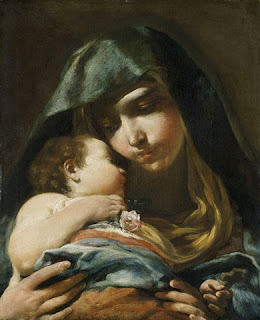Our culture does not like grief, and puts a lot of pressure on the bereaved to "find closure" (whatever the hell that means), and to get on with life. The angry cynic in me asks, "in whose interest is it to 'put this behind and to get on with life'?"
Sure, we recover from the loss of those we love, like we recover from an amputation. Life goes on, and so do we, but we are never really whole again.
Nothing in this world is worse than for parents to see their children die before them. That is worse than death itself. And now scores of parents are going through that worst of pain right now in Connecticut. I can't imagine anything we could say or do that could possibly mitigate that suffering other than to offer our sympathies and to share their sorrow as best as we can.
For the rest of us who have not been directly touched by this horrific event, but who have been preoccupied with it, here are some images in which we may find some consolation.
The first is by Adolphe Bouguereau, The Virgin of Consolation from 1875.
I must confess that I'm not all that fond of this picture. It's beautifully painted, and yet the sentiment rings hollow. But it is a painting specifically about the loss of children.
At first I thought it was striking how few images there are in art about grieving for the loss of a child, especially from ages where child mortality was much more commonplace than in our time or in Bouguereau's time. Then I realized how much religious imagery really did address that subject directly and indirectly from numerous versions of the Massacre of the Innocents to the Pieta.
Probably the most common image intended to console the bereaved over the death of children was the Madonna with the sleeping Christ Child. A sleeping Christ Child always foretells His death, which tradition says His Mother foresaw. I've already reproduced one of the finest of these by Giovanni Bellini in a previous post. Here are some others.
Andrea Mantegna
Piero della Francesca
In this case, the sleeping Child refers to the recent death of the Duchess of Urbino, Battista Sforza. Her namesake saint, John the Baptist points to the Child and to the empty place where she should be in the painting opposite the armored Duke, Frederigo da Montefeltro, who commissioned the painting.
Sassoferrato
The 17th century artist Sassoferrato painted a number of these, many very beautiful like this one.
Sassoferrato
Another version of the picture above, the same composition reversed
Giuseppe Maria Crespi
My personal favorite consoling image, much on my mind lately, is this detail from Rembrandt's famous "Hundred Guilder Print" showing the entire 19th chapter of the Gospel of Matthew.
Rembrandt shows verses 13 and 14 in this detail:
"Then were there brought unto him little children, that he should put his hands on them, and pray: and the disciples rebuked them.A mother presents her infant while Peter tries to send her away. Behind her, another mother with an infant is directed by her toddler who eagerly strides toward Christ. His dog wonders at the commotion.
But Jesus said, Suffer little children, and forbid them not, to come unto me: for of such is the kingdom of heaven."
Behind them, the Rich Young Man sulks after getting an unwelcome answer to his question. The Scribes and Pharisees plot to catch Jesus with legal sophistry. To the right of Christ, the sick and suffering plead for relief.
None of these children is particularly darling except maybe to their mothers. They do nothing to plead for our sympathy or to tug our heart-strings. Rembrandt shows sympathy without resort to sentimentality.







3 comments:
Lovely post, Doug, and consoling, too. As they say, a picture is worth a thousand words.
I don't care for the Bouguereau, either, but that's no surprise, because I'm not a great admirer of his paintings.
This is a lovely post Doug, and your comment on our culture being unable to deal with grief. But to be honest we don't deal with feelings of any kind well either...sadly.
I think it is important to note that there is not a word for a parent who has lost a child. We name persons, situations to give them a social context. When a spouse dies, you are a widower or widow; when a parent dies you are an orphan. But there is no name, no word for a parent who has lost a child --there is no social context --it is un-nameable. It is, therefor, almost un-thinkable.
So, indeed, these pictures are worth a thousand words....
Thank you Doug.
Post a Comment